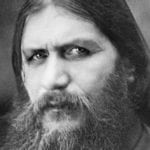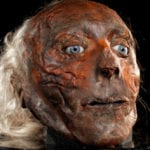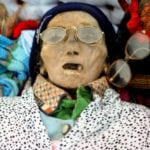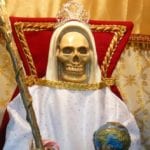 Movies and TV
Movies and TV  Movies and TV
Movies and TV  Humans
Humans 10 Times Scientists Were Absolutely Sure… and Absolutely Wrong
 Our World
Our World 10 Pivotal Moments for Life on Earth
 Movies and TV
Movies and TV 10 Most Realistic Medical TV Shows of All Time
 Creepy
Creepy 10 Eerie & Mysterious Ghosts of the Pacific Coast
 Weird Stuff
Weird Stuff 10 Typos That Accidentally Changed History
 History
History 10 Times Trickery Won Battles
 Technology
Technology 10 Awesome Upgrades to Common Household Items
 Misconceptions
Misconceptions 10 Hilarious (and Totally Wrong) Misconceptions About Childbirth
 Weird Stuff
Weird Stuff 10 Warning Labels That Exist Because Someone Actually Tried It
 Movies and TV
Movies and TV 10 Zombie Movies That Will Actually Terrify You
 Humans
Humans 10 Times Scientists Were Absolutely Sure… and Absolutely Wrong
 Our World
Our World 10 Pivotal Moments for Life on Earth
Who's Behind Listverse?

Jamie Frater
Head Editor
Jamie founded Listverse due to an insatiable desire to share fascinating, obscure, and bizarre facts. He has been a guest speaker on numerous national radio and television stations and is a five time published author.
More About Us Movies and TV
Movies and TV 10 Most Realistic Medical TV Shows of All Time
 Creepy
Creepy 10 Eerie & Mysterious Ghosts of the Pacific Coast
 Weird Stuff
Weird Stuff 10 Typos That Accidentally Changed History
 History
History 10 Times Trickery Won Battles
 Technology
Technology 10 Awesome Upgrades to Common Household Items
 Misconceptions
Misconceptions 10 Hilarious (and Totally Wrong) Misconceptions About Childbirth
 Weird Stuff
Weird Stuff 10 Warning Labels That Exist Because Someone Actually Tried It
10 Relentless Personifications Of Death
Death is inescapable. Why is it we have to put a face to our inevitable end? It can’t be for comfort. Because the personifications humans have made for death are far scarier than a cold, merciless void.
10The Dullahan
The Dullahan is a headless horseman that moves with purpose through the Irish countryside. His head, which he carries in one hand, has pale glowing skin and a twisted smile that stretches from ear to ear. When the Dullahan holds his head up high, his beady black eyes can spot his target from a great distance. He rides a horse so fast that bushes catch fire as he passes. No matter how firmly a gate is locked, it will blow open to allow the Dullahan to enter. Once his severed head calls out your name, you immediately die.
Even those who aren’t the Dullahan’s targets should avoid him. He throws a pail of blood on passersby or strikes them blind using his whip, which is made of a human spine. This death rider does have a weakness though: He is inexplicably afraid of gold. When traveling the roads, it is best to carry gold in your pocket. Should the Dullahan ever run you down, drop the gold in front of him, and he will disappear with a frightful howl.
9The Washerwomen
The Bean Nighe is a fairy ghost from Scottish folklore. Legend has it that you can find her at a stream, washing the bloodstained clothes of someone who is about to die. A Bean Nighe is created when a woman dies during childbirth; her spirit becomes a fairy washerwoman until the day she would have normally died. She takes the form of a small woman who dresses in green and has red, webbed feet.
Unlike other death portents, this is one you’d want to find (just hope that it’s not your clothes she’s washing). If you stand between her and the water, she will grant you three wishes and permit you to ask her three questions to which she will answer the truth. But she will also ask you three questions that you must also answer truthfully.
The Bean Nighe has an Irish counterpart called the Bean Sidhe. But unlike their Scottish sisters, these washerwomen will wander away from the riverbanks, gathering around the houses of the doomed. Once they begin wailing, the condemned’s fate is set.
If you can catch a Bean Sidhe, you can get her to reveal the name of the person about to die. Look out for an old woman with eyes bloodshot from crying, long and scraggly hair, and large, pendulous breasts.
8The Plague Hag
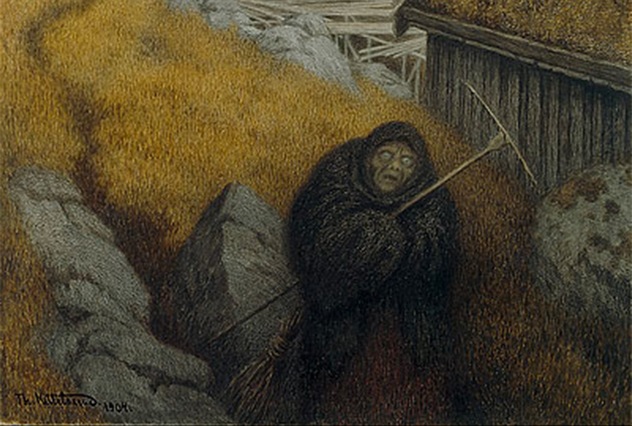
In 1349, a ship docked in Bergen, Norway, carrying the Black Death. The grain cargo was teeming with plague rats hosting infected fleas. For six months, the plague spread across Norway, killing 50 percent of the population.
The Norwegians personified the Black Death as an old woman known as Pesta, the plague hag. She carried either a rake or a broom. If she entered an area and began raking, many would die. If she swept with her broom, everyone would die.
Sweden also had the plague hag, but in their version, she was preceded by a man. The man carried a shovel, and if he entered a house and began shoveling, it meant some would die. If the plague hag followed in after him and began sweeping, everyone would die. And this time, she touched everyone in the house with her broom just to be sure.
Fortunately, the plague hag can be reasoned with, if you’re willing to accept death. In one tale, a boatman gives the hag a ride across the river. Upon correctly guessing her identity, she grants him a quick death as opposed to days of suffering from the plague. In another tale, a mother and her husband are sleeping with their child tucked between them, hidden under the blankets. The mother wakes up to find the hag sweeping her room. She begs, “In the name of Jesus, troll, there are no more to take here.” The hag chooses to believe her, so she kills the woman and her husband but spares the child.
7Thanatos

In Greek mythology, Thanatos was the son of Nyx, the goddess of night, and Erebos, the god of darkness. His twin brother was Hypnos, the god of sleep; the two of them lived together in the underworld, where they slept in the same bed. Thanatos had an angelic appearance, with feathery wings and a sword on his waist. His role was to collect the souls of those who died peacefully. The Greek poet Hesiod wrote:
“[Thanatos] has a heart of iron, and his spirit within him is pitiless as bronze: whomever of men he has once seized he holds fast, and he is hateful even to the deathless gods.”
Thanatos can be beaten, but it’s not easy. He was only once defeated through strength, when he came to reap the soul of Herakles’s friend. Herakles jumped Thanatos and sent him back to the underworld bruised and empty-handed.
Sisyphus had outwitted Thanatos. When it was Sisyphus’s turn to die, Zeus ordered Thanatos to chain Sisyphus up in Tartarus, but Sisyphus tricked Thanatos into his own shackles. While Thanatos was chained up in Tartarus, no one could die. The Olympians had to intervene to set things right. And for annoying the gods, Sisyphus was cursed to roll a boulder uphill for all eternity.
6The Netherworld Emissary
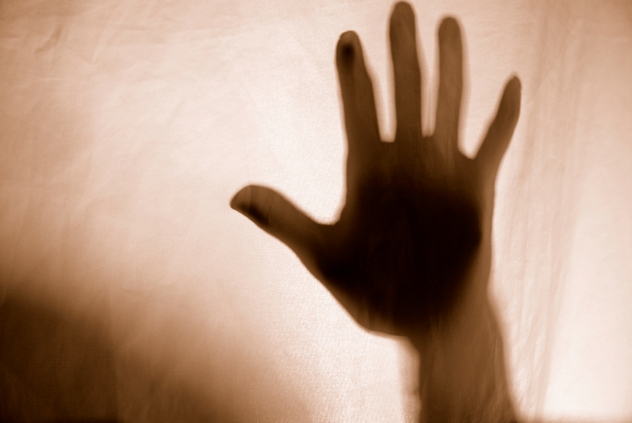
The Korean Grim Reaper is named Jeoseung Saja. His duty is to escort souls to the king of the netherworld to receive judgment. Jeoseung Saja dresses in long, black robes and a tall, black hat. Pale skin surrounds his sunken eyes. His weaknesses vary from province to province. In Chilgok, he will avoid silver and oranges, which can be used to ward off evil.
Long ago, on Geumo mountain, there lived a retired general who wished to avoid death. General Sineui had planted orange trees around the walls of his estate, forming a barrier to keep out the netherworld emissary. When Jeoseung Saja came for him, it spent days circling his estate. At last, Jeoseung Saja discovered a dastardly peach tree—peach was considered an evil fruit—and used that to climb over the walls. But that wasn’t Sineui’s only defense. Sineui had fastened his topknot with a silver pin. But Jeoseung Saja came in at night and hid under the floor. When Sineui went to the bathroom that night, Jeoseung Saja crashed up through the floorboards and reaped the general with an iron hammer.
Sineui was able to escape the underworld. However, his family had buried him after the funeral. When his soul returned to his body, he suffocated and died again.
5Shinigami
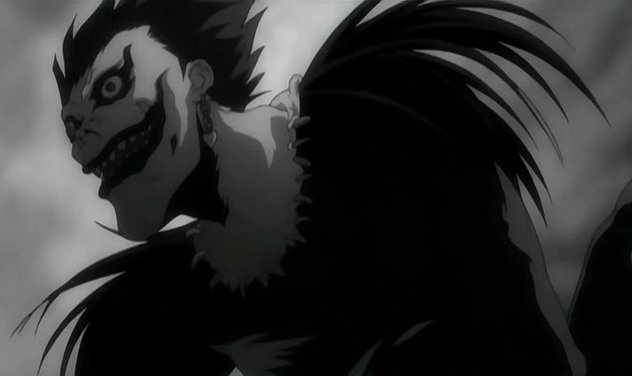
The Japanese Shinigami have become popular recently due to appearances in manga comics like Death Note, which portrays them as a race of demonic creatures. These Shinigami extend their own lives by writing a human’s name on a magical piece of paper called a death note. When a Shinigami writes down a name, the human instantly dies, and the Shinigami steals the remaining years of the human’s life, adding them to its own lifespan. The story begins when a bored Shinigami decides to give his death note to a human.
But the Shinigami in Japanese folklore are much different, although it might be disingenuous to say they are a part of folklore because the concept of these spirits did not arise until the 19th century. They are based on the Western Grim Reaper and even feature a similar look. The folklore Shinigami measured human lifespans with candles. When a person’s candle extinguished, it was time for that person to die. The candles of handsome and wealthy people burned faster than others.
If you are sick, you will see a Shinigami sitting at the foot of your bed, waiting for you to take a turn for the worse. If you are surely about to die, Shinigami will be standing over you.
4The Ankou
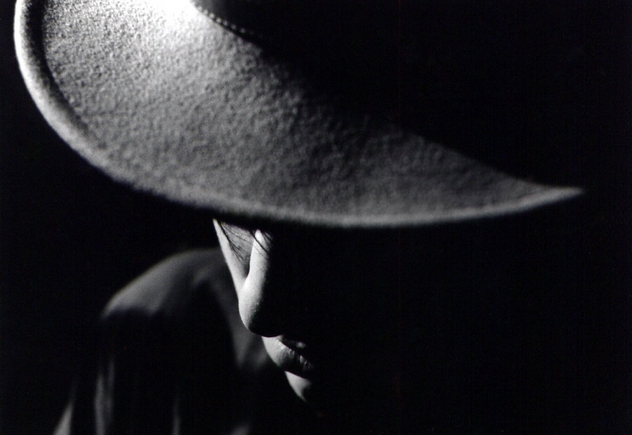
In Breton folklore, the Ankou collects dead souls from graveyards and carries them in a coach to the underworld. In each parish, the last person to die in the calendar year becomes the Ankou for the next year. If there are a lot of deaths during the year, the Ankou is said to be particularly wicked.
The Ankou looks like a tall, thin man dressed in a long coat, with a wide-brimmed hat shading his face. He drives a coach pulled by two white horses: one young and healthy, the other old and withered. When the Ankou patrols a graveyard, his head rotates in a continuous circle, like a mute siren, so that the souls of the dead cannot escape his sight. In some accounts, two skeletons follow the Ankou. These skeletons round up fleeing souls and toss them into the coach.
3The Angel Of Death
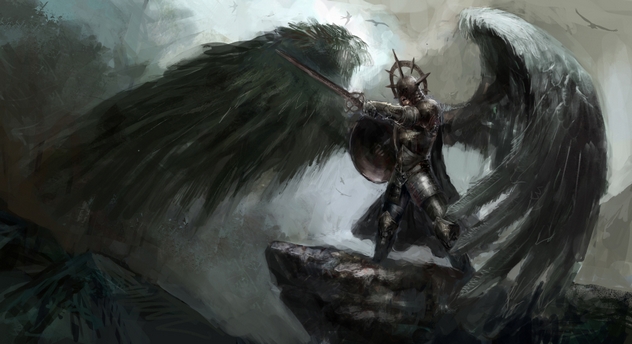
In Judaism, God created the Angel of Death on the first day of creation. God later said to the angel, “Over all people have I surrendered thee the power.”
The Angel of Death has 12 wings and his body is covered in eyes. At the hour of your death, this angel stands over your head with his sword drawn. Once you see him, you will be seized by convulsions, and your jaw will lock open. Bile drips from the angel’s sword into your mouth, turning your face putrid yellow and killing you. The saying “it tastes of death” is believed to have originated from this ritual.
Once you see the Angel of Death, you will absolutely die. However, though the angel himself does not distinguish between good and evil; he follows the orders of God. By confessing sins and living a benevolent life, it is possible to convince God to keep the Angel of Death at bay.
2Cu Sith

In the Scottish highlands, beware a dog the size of a young bull, with paws like human hands. Its shaggy fur is dark green, the color of fairies. “Cu” means “dog,” and “Sith” means “fairy.”
The Cu Sith will bear down on you in a straight line. If you hear its echoing howl three times, you will drop dead. But if you can hide and escape before the third howl, you will be spared, for a while.
But this fairy dog is more than just a harbinger of death. It’s also a caretaker of the fairies. If the Cu Sith finds a nursing woman, it may let her live and abduct her instead, bringing her back to the fairy mounds to force her to provide milk for the fairy children.
1Grim Reaper
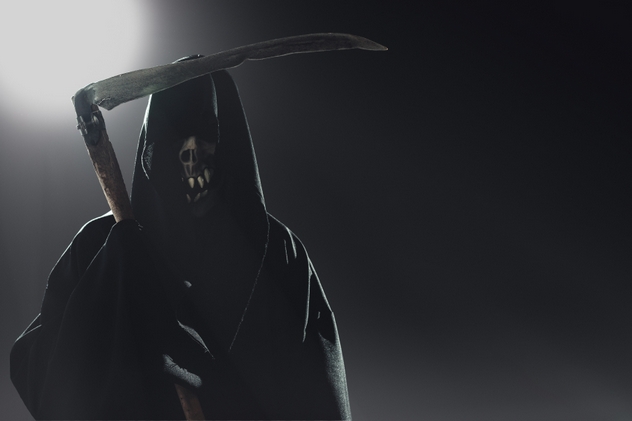
Until the 14th century, Christian artwork had personified death as an angel or angels. But then the Black Death killed 30–60 percent of Europe’s population. After living in sickness, with bodies piled in the streets, artists changed their view of death. No longer a godly angel, Death was now drawn as a grim skeleton. Depictions of the plague had Death picking off people with crossbows or darts. As the plague worsened, artists gave Death a scythe, a reaping tool. They showed him mowing down people like a farmer hacking through fields of wheat. Death now wore a black cloak, because that’s the color associated with mourning. He became the Grim Reaper, and that image has endured through the centuries.
Sometimes, the Grim Reaper rides a pale horse. In this incarnation, he is the Fourth Horseman of the Apocalypse who will lead the armies of the dead back to Earth.
For more lists like this, check out Matt’s blog.


